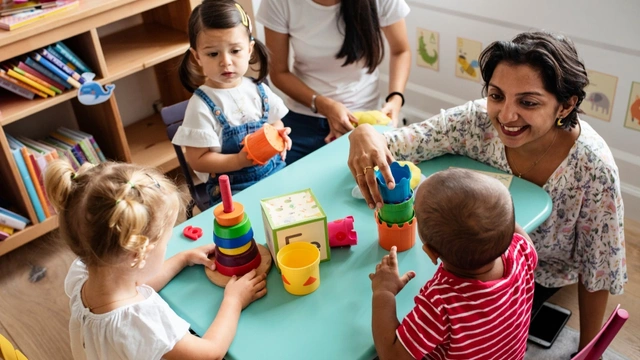It’s estimated that couples in the UK spend an average of 29%1 of their combined wages on childcare costs - the most expensive in the developed world. This has caused considerable challenges for families, particularly in the cost-of-living crisis. Even more so for the UK’s single parents when you consider the cost of living is £630 more expensive for a single-person household.
We delved into this and discovered that there has been an 86% increase in the number of Google searches for ‘nursery costs for 2-year-olds’ in 2022, as well as a 39% rise in searches for ‘nursery fees’ in the same period.
It has also been previously reported2 that one in four parents with school-age children have bought or rented a home within the desired catchment area of a school and are willing to spend an additional 12% of the market value of a home for this location.
But does living within the postcode of an Outstanding-rated nursery have an impact on property prices? And if so, to what extent?
Living near an Outstanding-rated nursery could cost an additional £71,995 when buying a property
We analysed 75 Ofsted Outstanding-rated nurseries, independent schools and primary schools (with a nursery) across the UK and discovered that, overall, it would cost £71,995 more on average to buy a property near an Outstanding-rated nursery.
The Most Expensive Nurseries to Live Nearby
|
Nursery Location
|
Average House Price in Nursery Postcode
|
Average House Price in Area
|
Difference
|
|
Chelsea, London,
SW3 5JE
|
£6,010,000
|
£2,236,126
|
£3,773,874
|
|
Ewell, Epsom, Surrey,
KT17 3AS
|
£1,250,000
|
£607,540
|
£642,460
|
|
Walthamstow, London,
E17 9SB
|
£1,160,000
|
£551,398
|
£608,602
|
|
Cambridge, Cambridgeshire, CB1 7ST
|
£830,972
|
£529,806
|
£301,166
|
|
Bishopston, Bristol,
BS7 8LS
|
£697,000
|
£445,201
|
£251,799
|
|
Grays, Essex,
RM17 5UT
|
£569,714
|
£319,543
|
£250,171
|
|
Battersea, London,
SW11 3ND
|
£1,233,619
|
£989,530
|
£244,089
|
|
Nunthorpe, Middlesbrough, TS7 0LA
|
£455,750
|
£212,641
|
£243,109
|
|
Southfields, London,
SW19 8EJ
|
£1,037,606
|
£935,658
|
£101,948
|
|
Liverpool, Merseyside,
L7 0LH
|
£237,500
|
£138,823
|
£98,677
|
|
Hammersmith, London, W6 7BE
|
£960,614
|
£864,320
|
£96,294
|
|
Levenshulme, Manchester, M19 2QW
|
£352,500
|
£257,466
|
£95,034
|
|
Croydon, Surrey,
CR0 6TY
|
£468,500
|
£384,612
|
£83,888
|
|
Prestwich, Manchester, Lancashire,
M25 1BP
|
£365,000
|
£302,177
|
£62,823
|
|
Prescot, Merseyside, L35 4NW
|
£252,500
|
£192,167
|
£60,333
|
Data collected 12/12/22.
Digging deeper, it could cost an additional £201,675 to live within the postcode of 51% of the total nurseries analysed.
The most expensive nursery to live nearby is in Chelsea, London - it will cost you an extra £3.7 million to purchase a house. The average house price within the postcode of this nursery is £6 million, compared to £2.2 million within the wider Chelsea area. However, Chelsea is a particularly affluent area, so we have made sure to analyse the average across 75 different nurseries within the UK.
The average house price in the postal district of the Outstanding-rated nurseries is £484,446
Delving deeper into the data, we can see that the average property price in postcodes with Outstanding-rated nurseries is £484,446. This is £188,446 more than the average house price in the country.
On average, it costs £71,955 more to buy a home in the postal district of a top UK nursery than it does in the wider area (i.e., surrounding region).
Of the top 10 most expensive nurseries to live nearby, four were in London - costing an additional £1.18 million
Parents in London could be paying the highest premiums to live within the postcodes of Oustanding-rated nurseries. Of the top 10 most expensive nurseries - based on the price difference between the nursery postcode and the wider area - four were in London and three within South West London. The average price increase for a property in the postcodes of these four nurseries is £1.18 million.
Most of the Outstanding-rated nurseries to live nearby were in the south, with two exceptions in the north. Of those two, it would cost an additional £243,109 to live within the postcode of a leading academy in Nunthorpe, and an extra £98,677 to live within the postcode of a top primary school and nursery in Merseyside.
In Surrey, living within the postcode of one of their Outstanding-rated nurseries costs an extra £642,460
The second most expensive Outstanding-rated nursery is found in Ewell, Surrey. To live within the postcode of the nursery, parents would have to pay an additional £642,460 more than the average house price in the area – that’s £347,901 more than the average house price in the UK.
Parents could face a 144% hike in property prices to live near the most expensive nursery in Middlesborough
A primary academy in Nunthorpe, featuring a nursery, could see parents spend an additional 114% on their property to live within the postal district. The average cost of property prices in the postcode district is £455,750, compared to £212,641 within the wider area. This is a staggering increase of £243,109.
In Merseyside, parents could spend up to 71% more on properties within the postcode of the most expensive nursery
The tenth most expensive nursery analysed (based on the difference in property prices compared to the average in the area) was in Merseyside. Here, parents could face an additional 71% to pay for their property, or £98,677.
Properties within the postcode of this nursery cost £237,500 on average, compared to £138,823 in the wider area.
This could suggest that parents have to pay more than just childcare costs when it comes to choosing a nursery for their child or children.
But if you are struggling with childcare costs, there may be help available.
How to get help for childcare costs
In the UK, some help with childcare costs is available for parents.
- 30 hours’ free childcare - Eligible families can receive 30 hours of free childcare for children aged three and four.
- 15 hours’ free childcare - Families on certain benefits - including income support, Universal Credit, JSA and ESA - with two-year-old children can get 15 hours of free childcare a week.
- You can claim Child Benefit if you are responsible for a child who is under 16 or under 20 if they stay in approved education or training. This is paid every four weeks and there is no limit to the number of children you can claim for.
- You may also be able to apply to claim back childcare costs (up to 85%) if you are eligible for Universal Credit.
You can find out more and who to contact on the government website.
For more information on tips for your home, including help for buying your first property, check out our blog.
Methodology:
We analysed 75 Outstanding-rated nurseries on the Ofsted website, sorting them by the latest reports. We then used the postcode or the street of the nursery to attain the average house price to compare that price to the average property price within the wider area. For instance, CB1 2LZ for nursery and CB1 for area house price.
If the average property price was not available, we totalled the cost of properties sold in that area from 2022 to 2107.
If house price data couldn't be accurately found, nurseries were not included.
Data sourced 12/12/22.
Sources:
1. https://data.oecd.org/benwage/net-childcare-costs.htm
2. https://www.independent.co.uk/money/spend-save/uk-parents-move-house-school-catchment-area-quarter-best-education-a7908046.html
Adele is a personal finance writer with more than 10 years in the finance industry behind her. She writes clear and engaging guides on all things loans for Ocean, as well as contributing blogs to help people understand their options when it comes to money.
![Email icon]()
Become a money maestro!
Sign up for tips on how to improve your credit score, offers and deals to help you save money, exclusive competitions and exciting products!









